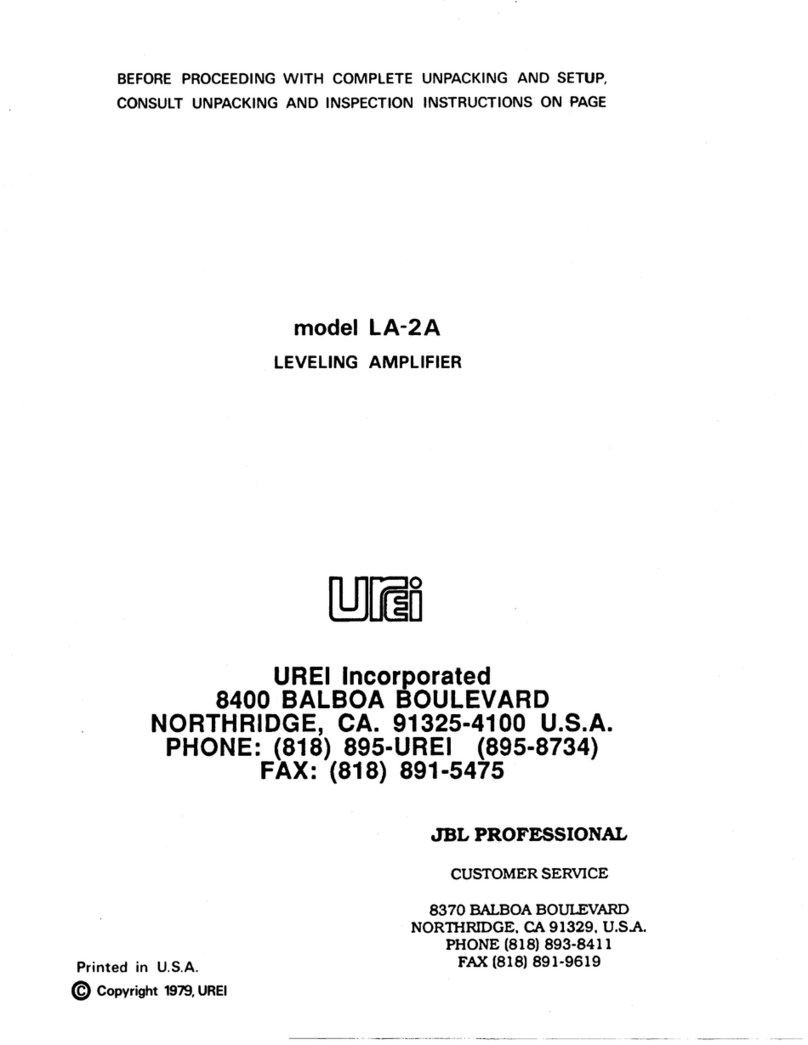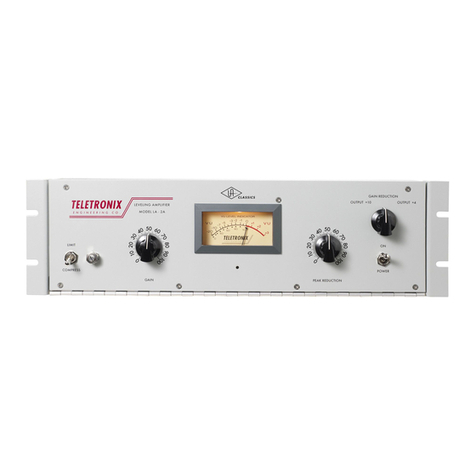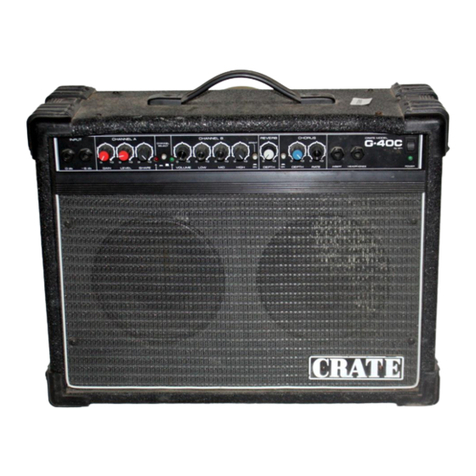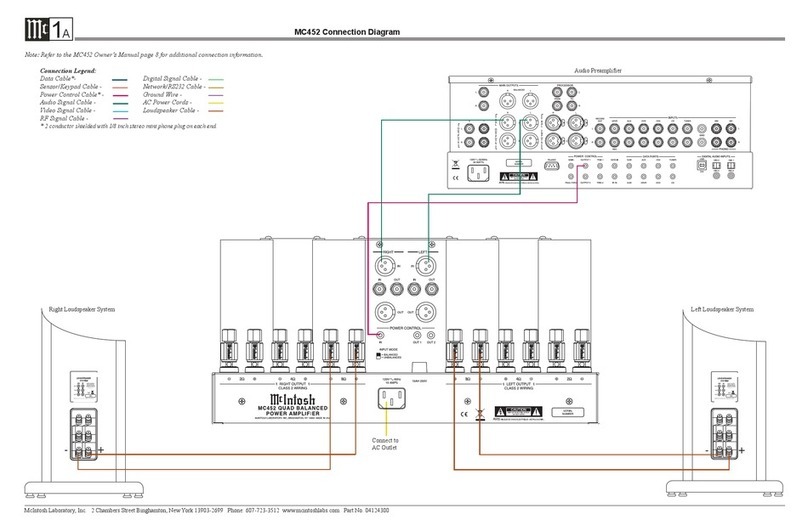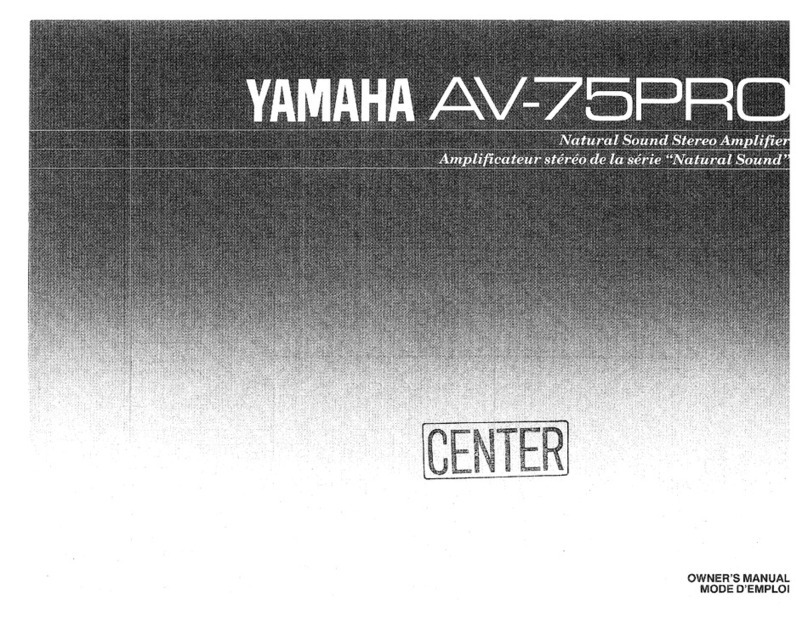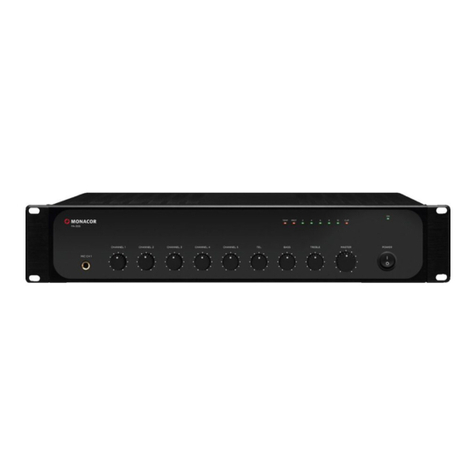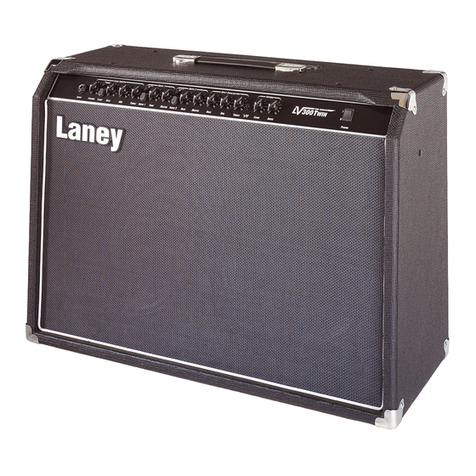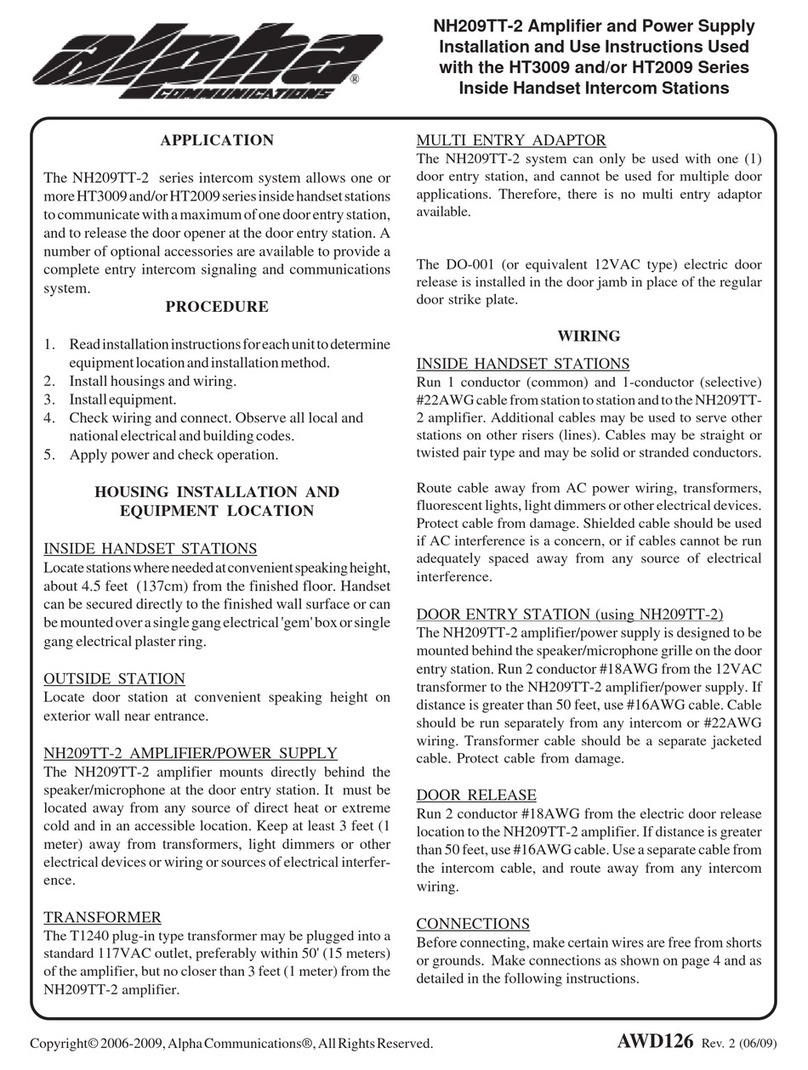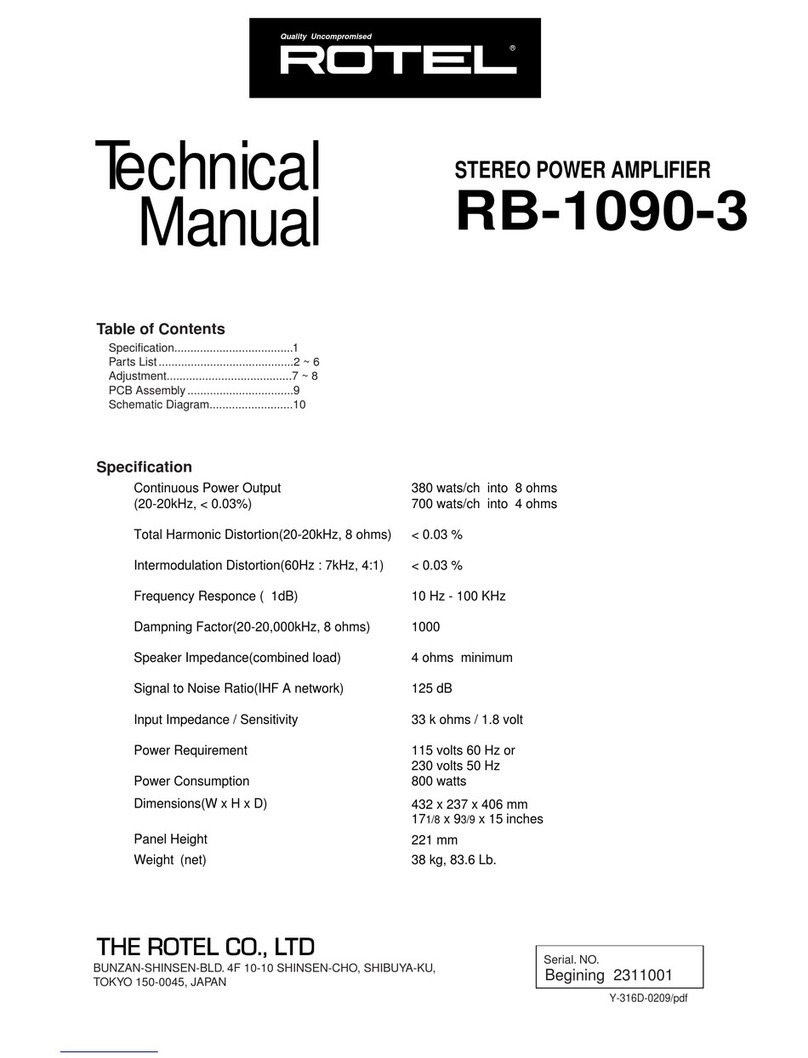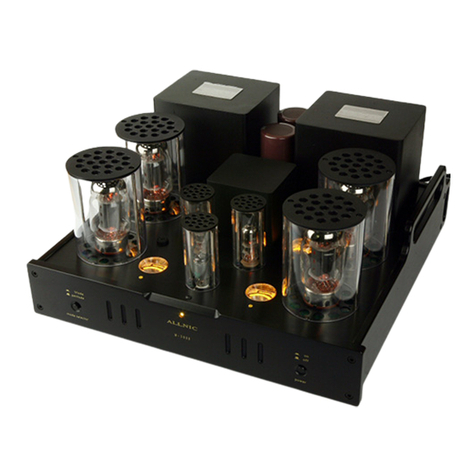TELETRONIX LA-2A User manual

www.SteamPoweredRadio.Com
'
I
r
r
I
r
I
r
r
I
[
[
[
[
l
[
l_
[
l
[
~
TELETRONIX
MODEL
LA-2.
11
..
LE7ELING
AMPLIFIER
INTRODUC':'I
ON
The
Teletronix
Leveling
Amplifier
will
automatically
lir.~t
audio
pea.ks
which
might
otherwise
over
drive
broadcast
~~
recording
equipment.
Automatic
gain
reduction
is
accomplished
by
the
use
of
an
electro-optical
vo.rio.ble
attenuator,
which
is
placed
a.head
of
the
first
amplifier
stage.
The
uttenurition
is
con-
trolled
by
the
amplitude
of
the
LA-2A
input
signal.
This
system
permits
up
to
40
DB
of
instantaneous
gain
r
.0
duction,
yet
co.uses no wave
form
or
harmonic
distortion.
The
amplifier
provides
sufficient
gain
und
output
level
(10
DBM
nominal)
to
be
used
as
a.
line
or
program
amplifier,
or
for
direct
connection
to
the
transmitter
in
the
case
of
radio
or
T.V.
operation.
Provisions
are
made
for
interconnection
of
the
optical
attenuators
to
provide
equal
gain
reduction
in
both
channels,
when two
of
the
LA-2A
Leveling
Amplifiers
are
used
for
FM
stereo
broadco.sting.
l.
Guin
Reduction:
2.
Distortion:
:>.
Response:
.
Noise:
l.'.
•
t"
Ga.in:
,,,
.
6 ,
·
Output
Level:
Input
Level:
LA-2A
(J-66)
SPECIFICATIONS
up
to
40
DB.
less
than
0.35%
total
harmonics
o.t
+10
DBM,
o.nd
less
thc.n •
75f{,
total
harmonics
at
+16
DBM.
±0,1
DB
30
cycles
to
15
KC.
75
DB
below
+10
DBM
output
level
40
DB
zl
DB
+10
DBM
nominal
+16
DBM
maximum
pea.ks
+
16
DBM
maximum
P
o.
ge
-2-

www.SteamPoweredRadio.Com
...__
..
~
...
-
I
f
I
I
I
I
I
I
I
I
I
I
[
I.
[
l
l
[
[
l
[
i
e,.
-~
..
t,ta1Jk
Time:
9Q
Release
Time:
10.
Input
Impedance:
11.
Output
Impedance:
essentially
instantaneoua
C~J
micro-sec.)
approximately
0.06
seconds
for
50~
release,
0.5
to
5
seconds
for
com-
plete
release
depending
upon
amount
of
previous
reduction.
50,
150,
250, and
600
ohms.
balanced
or
unbalanced.
50,
150,
250, and 600 ohms.
balanced
or
unbalanced.
12.
··
output
Source
Impedance:
approximately
150 ohms.
at
800 CPS.
13.
Panel
Size:
14.
Depth
Behind
Panel:
15'.
Panel
Controls:
16.
Meter:
17.
Power
Requirements:
18.
Tube Complement:
19.
Fuse:
standard
19"
x
5¼"
7
,1.tt
. 4
Gain
(input
level),
Peak
Reduction
and
Meter
Selector
Switch.
DB
Gain
Reduction
and
DB
Output
115/230
volts
50-60
cycle
35
watts
(2)
12AX7A
(1)
12BH7A
(
l)
6AQ.5
JAG,
3/8
AMP
Slow Blow
for
115V;
JAG
15/100
AMP
Slow Blow
for
230V.
CIRCUIT
DESCRIPTION
The
LA-2A
Leveling
Amplifier
will
produce
essentially
instantaneous
gain
reduction
of
over
40
DB
with
no
increase
in
harmonic
distortion.
A
typical
gain
reduction
curve
for
this
system
is
illustrated
on
Figure
1.
Compressor
action
occurs
from
the
br·eakaway
point
at
-30
DB
input
and up
to
-20
DB,
at
which
point
the
curve
becomes
horizontal
to
exhibit
limiting
action.
The
.
!nput
increases
an
additional
20
DB,
but
the
output
increases
less
than
l
DB.
The
leveling
amplifier
thus
combines
the
ohar-
act~ristics
ot
a
compressor
and
limiter.
A
reasonable
amount
~r
care
in
gain
riding
will
restrict
normal
operation
to
the
compression
region,
but
uncontrolled
output
levels
will
be
p~evented
by
the
limited
action.
LA-2A
(3-66)
,._.
Page
•3•

www.SteamPoweredRadio.Com
r
l
;J
1
~e
ilea.rt
of
t~1.e
leveling
amplifier
is
the
Eila
~
t1
::,
~
q
:d
:/
.0c
.l
3.-t,
tenuator
which
is
placed
ahead
of
the
first
a."'!'ln~
_
i.fi
e::-'
::.
t.P.
6
e.
The
actual
stage
gains
and
tube
operating
paramet
e
rs
,
.:.re
not
varied,
permitting
the
tubes
to
operate
at
optimun
e:
.
ondi
tions
regardless
of
the
amount
of
gain
reduction.
The
optical
attenuator
consists
of
a
photo
conductivP.
cell,
which
is
optically
coupled
to
an
electro-luminescent
light
source.
The
electro-luminescent
device
provides
a
light
intem;i
ty
which
is
proportional
to
the
audio
voltage
applied
to
its
terminals.
Not
unlike
a
capacitor
in
construction,
the
electro-luminescent
lamp
consists
of
a
plate
of
glass
or
plastic
coated
with
a
clear
conducting
material
on
one
.
side
an~
a
thin
layer
of
phosphor
on
the
other
side.
A
metallic
plate
contacts
the
phosphor
coating.
As
alternating
current
is
applied
to
the
conducting
plates
the
phosr
~·
phors
are
excited
by
the
voltage
across
the
dielectric
and
light
is
produced.
The amount
of
light
depends
upon
the
applied
voltage
and
frequency.
The
gain
or
level
controlling
element
is
the
photo
conductive
cell.
The
resistance
of
the
cell
decreases
with
an
increase
in
the
impinging
light.
Since
the
light
is
produced
directly
from
the
audio
voltage,
the
response
is
instantaneous.
Rectification
and
filtering
of
the
audio
to
produce
a
control
signal
are
not
necessary
as
in
the
case
of
conventional
limiters;
This
system
results
in
automatic
level
control
whose
speed
of
operation
is
limited
only
by
the
response
of
the
variable
resistance
photo
cell
used.
A
cell
is
selected
which
provides
minimum
attack
time,
and
a
release
time
which
requires
about
60
milliseconds
for
5o%
release,
and
then
a
gradual
release
over
a
period
of
1
to
15
seconds
to
the
point
of
complete
release.
Refering
to
Figure
2,
the
functional
block
diagram,
t
he
imput
signal
is
applied
directly
to
the
optical
attenuator
from
the
high
impedance
winding
of
the
input
transformer.
The amount
of
attenuation
introduced
by
the
optical
attenuator
is
controlled
by
the
audio
voltage
applied
to
it
by
the
6AQ5
(V4)
luminescent
driver
amplifier.
The amount
of
signal
applied
to
the
12AX7
(V
l)
voltage
amplifier
is
also
controlled
by
the
manual
gain
control
.
The
voltage
amplifier
stage
provides
a
gain
of
40
DB.
Over
a
ll
amplifier
feedback
of
approximately
20
DB
provides
low
distortion
,
flat
response,
and
gain
stability.
The
output
stage
is
somewhat
unconventional
in
that
a
totem
pole
or
double
cathode
follower
is
used.
This
output
stag
e
can
tolerate
great
amounts
of
output
impedance
mismatch,
but
1·etains
low
distortion
and
flat
frequency
response.
:
·6:'
·
.-:For
sterea
-~br.oadctµ1t,-.g··
a.pplmcat!ons
.a
:·.
portion
;
•of
the
input
signal
is
fed
through
the
gain
reduction
control
to
the
12AX7
control
amplifier
(V3). The
output
at
this
stage
is
LA-2A
(J-66)
Page
-4-

www.SteamPoweredRadio.Com
I
I
I
I
I
I
I
I
I
I
I
I
I
l
I
I
I
I
I
r
i
..
::r9plied
to
the
stereo
bo.ln.nce
control
und
is
also
brought
out
tr;
a.
terminal
on
the
cha.sis.
For
stereo
operation
this
tern.-
inn.~.
is
connected
to
the
some
terminal
on
a.n
identica.l
a.mpli-
.::i,
:;;
r and
the
control
vol
to.ge becomes
common
to
both
uni
ts.
A
g,1
L1••reduction
control
voltage
generated
in
either
o.mplifier
will
co.use
equ~l
gain
reduction
in
both
units.
The
control
T.-
•c,l
toge
is
applied
through
the
stereo
bu.lo.nee
control
to
the
t·A
(c
~5
driver
amplifier.
This
sto.ge
provides
the
necessary
voltage
to
operate
the
electroluminescent
light
source.
OPERATION
The
LA-2A
Leveling
Amplifier
is
designed
to
prevent
o.n
increase
in
output
level
beyond
a.
pre-determined
point,
and
due
to
its
unique
design,
functions
a.s
a.
combined comp-
ressor
and
limiter.
The
effect
is
illustrated
in
Figure
l.
The
point
at
which
the
compressed
curve
breaks
a.way
from
the
straight
"No-Ga.in
Reduction"
line
is
determined
by
the
setting
of
the
"Peak
Reduction
11
control.
It
ca.n
be
seen
from
the
curve
tho.t
compression
occurs
o.nd
gro.duo.lly
increa.ses
over
the
first
10
DB
of
input
level
rise.
The
slope
of
tho
curve
then
becomes
horizontal
preventing
an
increase
of
output
level
re-
gardless
of
input
increase.
CONTROL
SETTINGS
It
is
recommended
that
the
"Peak
Reduction"
control
be
set
to
prevent
increase
in
output
level
beyond
the
100%
modulation
point.
This
setting
should
be
made on
typical
progrrun
material.
Setting
of
the
"Go.in" and "Peo.k
Reduction"
controls
are
independent.
However,
the
"Go.in"
control
should
be
set
to
provide
sufficient
output
a.f'ter
the
"Pea.k
Reduction"
oon-
trol
ho.s
been
adjusted.
The "Peo.k
Reduction"
control
should
be
set
for
the
desired
amount
of
gain
reduction
as
indicated
by
the
meter ..
Continuous
extreme
reduction,
such
as
20
or
30
DB
does
tend
to
reduce
the
dynrunic ro.nge
of
music.
Maximum
benefit
is
obtc.ined
by
running
4
to
8
DB
of
compression
continuously.
Thir,
will
usually
cause
full
limiting
to
occur
when 100% mod-
ulation
is
upproo.ched.
For
ease
of
control
and
to
prevent
overload
of
th
o
input
transformer,
sufficient
fixed
po.d
should
· be
pluccd
cch
cc.d
·
of
the
LA-2A
to
allow
normal
output
a.t
approximately
5o%
set
..
ting
of
the
go.in
control.
LA-2A
{3-66) Page
r~
-
,....,·
·
,;

www.SteamPoweredRadio.Com
r
f!
[
(
I
(
I
I
I
I
I
I
I
I
I
I
I
I
I
I
The
VU
Meter
servos
two
functions:
it
indica.tes
out-
t:u:
L.
level
a.s
well
a.s
go.in
reduction
directly
in
DB.
When
the
.
11
c1
tor
selector
switch
is
pla.ced
in
the
"Output"
position
the
meter
will
indicate
output
level
a.cross
the
600
chm
terminals.
'
rhe
meter
is
culibra.ted
to
rend
O
VU
or
loo% when
the
amplifier
o-..1tput
if
+10
DBM
or
+11-
DBM,
depending
upon
the
switch
position.
The
position
marked
11
Ga.in
Reduction"
permits
the
meter
to
indica.te
the
a.mount
of
go.in
reduction
or
pea.k
limiting
directly
in
DB.
During
periods
of
no go.in
reduction
the
pointer
will
return
to
O
VU
on
the
meter
sea.le.
The
pointer
is
initia.lly
set
to
this
position
by mea.ns
of
the
screw
driver
a.djusted
pot
loca.ted
on
the
left
end
of
the
front
pa.nel.
STEREO
If
two
LA-2A
Amplifiers
a.re
to
be
used
in
tandem
stereo,
the
go.in
reduction
of
ea.ch
amplifier
ca.n
be
ma.de
regardless
of
which
cha.nnel
is
instigating
the
limiting.
is
accomplished
by
inter-connecting
terminals
6
a.nd
7
or
LA-2A
Amplifiers.
The
inter-connecting
wire,
should
not
over
two
feet
in
length
a.nd
should
be
shielded,
the
ends
shield
being
connected
to
tho
#7
terminals.
(ground.)
Stereo
"set-up"
is
as
follows:
for
equa.l,
This
the
be
of
tho
1.
Connect
the
input
terminals
of
the
left
and
right
channel
LA-2A
•s
to
a.n
a.udio
oscillator.
Ma.kc
sur
e
that
the
amplifiers
a.re
connected
in
phase
to
the
genera.tor.
A
genera.tor
frequency
of
400
or
1000
cps.
is
sa.tisfa.ctory.
Generator
output
level
should
be
set
to
the
o.vera.ge
level
to
be
applied
in
operation.
2.
Place
the
meter
selector
switches
in
the
+10
or
+4
position
a.nd
a.djust
the
LA-2A
"Ga.in"
controls
!'or
equo.l
output.
The "Pea.k
Reduction"
controls
must
be
set
to
·
full
counter-clockwise
or
off.
J.
Ma.ke
sure
thnt
the
screw
driver
o.djust4
pots
(R3)
on
the
rear
of
ea.ch
unit,
a.re
"full
on".
(clockwise)
Pla.ce
ea.ch
meter
selector
switch
in
the
"Ga.in
Reduction"
position.
4.
Advance
the
"Go.in
Reduction"
control
on
the
left
chrinne2.
omplifier
until
o.pproximo.tely
5
DB
of
reduction
is
indic-
ated
on
the
meters.
Note
which
cha.nnel
is
indicating
the
most
go.in
reduction.
Reduce
the
setting
of
R3
on
this
unit
until
both
meters
show
equal
reduction.
LA-2A
(3-66)
Page
- 6-
t
l

www.SteamPoweredRadio.Com
I
I
I
I
I
I
I
D
I
,.
5.
The
"Gain
Reduction"
controls
can
now
be
placed
at
any
desired
setting,
keeping
both
knob
settings
equal.
Gain
Reduction
will
now
be
equal
on
both
channels.
G~IN
REDUCTION FREQ.UENCY' RESPONSE
·uoNTROL
FM
broadc
·
asting
and
TV
aural
transmission
systems
use
audio
pre-emphasis
in
the
transmitter.
The
standard
is
17
DB
increase
in
response
at
15
KC,
the
exact
curve
being
the
result
of
a
75
micro-second
network.
The
program
frequencies
in
the
vicinity
of
15
KC
will
modulate
the
carrier
17
DB
more
than
frequencies
below
1
KC.
Thus,
if
the
program
material
contains
a
large
amount
of
high
frequencies,
over-modulation
may
occur
if
the
levels
had
been
previously
adjusted
for
program
material
with
less
high
frequency
content.
An
attempt
to
alleviate
this
problem
has
been
made
by
others
in
the
form
of
level
controlled
high
frequency
cutoff
filters
and
high
end
peak
clippers.
Because
the
-amount
of
control
over
the
remainder
of
the
spectrum
is
limited
and
because
of
the
high
distortion
created,
such
devices
have
found
only
limited
application.
The
Teletronix
Leveling
Amplifiers
are
capable
of
at
least
30
DB
of
gain
reduction
or
limiting
with
less
than
0.5%
harmonic
distortion.
For
most
applications,
such
as
AM
broad-
casting
and
recording,
the
amount
of
gain
reduction
is
a
function
of
input
level,
and
is
independent
of
frequency.
By
increasing
the
gain
reduction
at
the
higher
frequencies,
the
over-modulation
caused
by
the
pre-emphasis
can
be
greatly
reduced
or
eliminated.
While
it
is
possible
to
increase
the
gain
reduction
sensitivity
on
an
inverse
of
the
pre-emphasis
curve,
this
usually
results
in
an
insufficient
leveling
on
the
low
frequencies.
The
actual
amount
of
the
limiteflpre-emphasis
must
be
determined
according
to
the
amount
of
high
frequency
content
in
the
program
material.
Adjustment
of
the
gain
reduction
frequency
response
is
accomplished
by
control
R37
which
is
located
on
the
rear
of
the
LA-2A.
Increasing
the
resistance
of
R37
reduces
the
amplitude
of
the
low
frequency
voltage
applied
to
the
Peak
Reduction
control,
R2. The
high
frequency
components
are
not
affected
because
of
the
low
reactance
of
Cl2.
Thus,
if
the
control
is
set
to
the
"flat"
position
the
LA-2A
will
provide
equal
gain
reduction
on
all
frequencies.
If
the
control
is
moved away
from
the
"flat"
position
the
leveling
will
be
greater
on
the
high
frequencies.
The
actual
setting
can
be
best
determin
e,-:
on
program
material
for
a compromise
between
low and
high
frequency
limiting.
Maximum
high
frequency
response
will
provid
e
approximately
10
DB
more
reduction
at
15
KC
than
at
frequencies
below
l
KC.
.
..
LA-2A
(3-66)
Pago
-7-

www.SteamPoweredRadio.Com
I
I
I
I
I
I
I
I
I
I
I
I
I
I
m
D
I
I
I
I
,
i)'LV..Qf.T
IMPUT
The
LA-2A
is
set
for
a
power
line
voltage
of
115
V when
.
shipped.
In
order
to
change
this
for
230
volts,
open
the
front
panel
and
make
the
following
changes:
Locate
the
vertical
solder
terminal
strip
at
the
right
hand
end
of
the
chassis.
Terminal
1
is
connected
to
2 and 3
is
connected
to
4
for
115
V
operation.
Remove
these
jU?pper
wires
and
connect
Terminal
2
to
3.
This
will
allow
operation
on 230
volts
±_10%,
50/60
cycles.
LA-2A
(3-66)
Page
-8
...

www.SteamPoweredRadio.Com
J
...,
liiiiiia - - - 11!::::1]
~
- - -- - -
-
....,
--
-
IP':
~-
...-
....
-
,..,
._-
TYPICAL GAIN REDUCTION PLOT
FO
R
MODEL
LA-21\. LEVELING i;_MPLIF'IER
I
·'
I
+20
/
.
--
- -- -I
i
I
I
...
15
I,/
/
.,
~,
+10
OUTPUT
C
NCREASE
_
v,
NO
GAIN REDUCTION
v·
m
A
...:i
~
+5
~
/
'
I
I
-----
---
--·
.
. ···~·
··
--
-:qH'l'PU!
-=
n
CREASE
-
-----
-:
REBB#.r-:
-~·
~;
--
1..-
............
-w
...
i .u
u.t-1.Li,
~
p..
~
v·
0 0
--·
I
,
J
!
. I
-5
-35
-30
-25
-20
-15
-10
-5
0 "
+5
INPUT LEVEL
DBM
TELETRONIX ENGINEERING
COMPANY
FIGURE
l

www.SteamPoweredRadio.Com
..t
lliiiil
u.l
(- I- I
r1:::::;;
rw-
r
m.11
callll
callll
-
tiall
-ta111
·,-
---
~ -
NEGATIVE
FEEDBACK
..-----------
--- ------
--
- -
···
---· .
GAIN
INPUT
INPUT
LJ
OPTICAL
~
'VOLTAGE
TRANSFORMER
ATTENUATOR
~
)
AMPLIFIER
T
1
·"
., {
12AX7)
1-t-n
.__
Vl
CATHODE
---'>~I
FOLLOWER
(12BH7)
V2
OUTPUT
1-
-0
---l.~RANSFORMER
OUTPU!
R37
0
✓
r,li
-
G.
AIN
REtUCTION
~--;
•
FREQUENCY
RESPONSE
CONTROL
VOLTAGE
I
;<
>I
AMPLIFIER
/
{12AX7)
PEAK
REDUCTION
CONTROL
Lll.-2A.
(J-66)
VJ
ELECTRO-
I .
2'
1LUMINESCENT
STEREO
BALANCE
DRIVER
(6AQ5)
V4
\
STEREO
INTEROQNNEG
LIMITER
BLOCK
DIAGRAM
FIGURE
2

www.SteamPoweredRadio.Com
I I
l I
rI
[
[1
~,
'
:~
JU
MPER
PL
U
GI
PAD
INPUT
OR
?R[
-[
MPhAS
IS N£TWORK
Tl
i~~
ox
'
600
2S0
c:r:
2S0
C
~.i.,
6JO -
TBI
-
R3'3
ZZOK
R3S
V3
2ZOK
lZAX7A
V4
GAGS
A
C7D
+
3o/4SOV
SOMfO.
·
2sv
R3
IM
ca
.o~
NOTIS:
CD
FOR
230V.
CONNECTION
SEE
MANUAL.
2.
-
®
PATENTS
PEN
OI
N
G
ON
11
SV
(!)
R32
IK
R~I
IK
FOATIONS
OF
THIS
50-601"\J
EQUIPMENT.
0,
VALVE
S[LEC.
T
E.D
rD
MA
TCI-I
T4A
FOR
lO
fl
f'l.ECr
''
DB
GA
IN
R[DU
CTJ0
>
./
1
R£ADJN6
.
ltJll7
P.RINTaO
ON
NO
.
1000H
Cl.11.Allll'"INT
R6
R7
681<
RS
68K
3 2
.2
M
Cl2
-
,OQI
CG
.01
R30
47K
T3
C7C
...J±
IO
/
4
2
0
~
~
C2
I
ZZO
.
AX
7
A~
1--.
--1-,
AIN
I
I" i
:.l
•
,
vi
.02
7
----
----
3
RII
68K
8
l•
.2
V
Rl2
RIO
470K
I.SK
1-1
Rl5
470K
R28
470K
NE-2
RZ9
CR-
!
}---.,.._-...-~v\f\/V\ifv--""?"""---
21sv
4.7K
2W
.
D
~
C7 +8
o
40
/4
SOV
40/4SOV
. 6,3 V
TO
HE
A
TERS
\---~~-.
AND
Mf_T[R
LA~'lP
R22
33~
128H7A
-
-
Z[RDADJ
.
R4
IM
R25 ®
18-
68
K
R23
6.8K
TB
2 OUTPUT
600
C.T.
600
t
GROUND
ST
E
R£::)
PA
R
ALLE
L
METER
SLECTOR
I.
OUTPUT +
10
2.~
IN
REDUCT
I
ON
+ l
OU
TPUT
+4
VU
METER
SC
H
EMAT
I
C-LEVE
LI
NG
AMPL/rIER
MODEL
LA-2A
Af>,.ROVl:D
ltY
:
DRAWN
BY
0
,.n:
, 12-21-
es
REVIHD
3 -
18
-
61,
T
£LETRO
NIX
ENG
IN
EER
ING
CO.
SOUTH
PASADENA,
CA
U
F.
CRAWINQ
NUMltlER
S-
10
14-
IJ
Other manuals for LA-2A
2
Other TELETRONIX Amplifier manuals
Popular Amplifier manuals by other brands
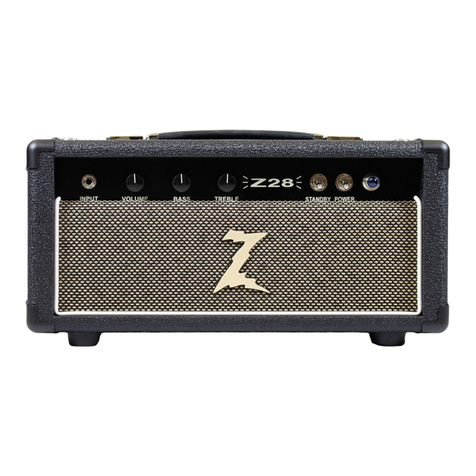
DR. Z Amplification
DR. Z Amplification Z-28 user manual
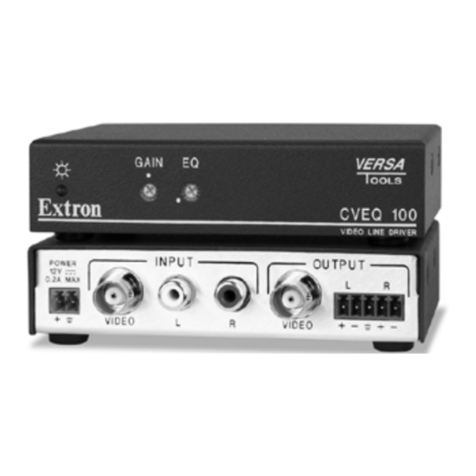
Extron electronics
Extron electronics Video and Audio Line Drivers with Gain and EquaLization CVEQ 100... specification

MTX
MTX Road Thunder RT251D owner's manual
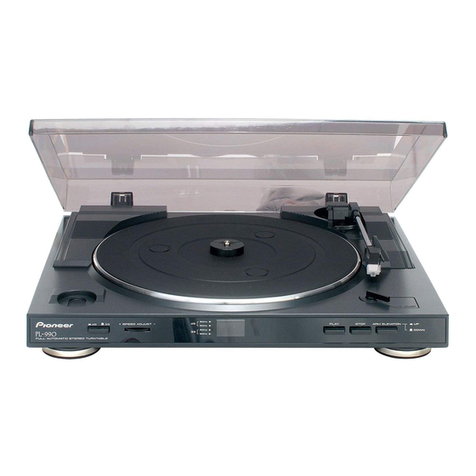
Pioneer
Pioneer PL-990 manual
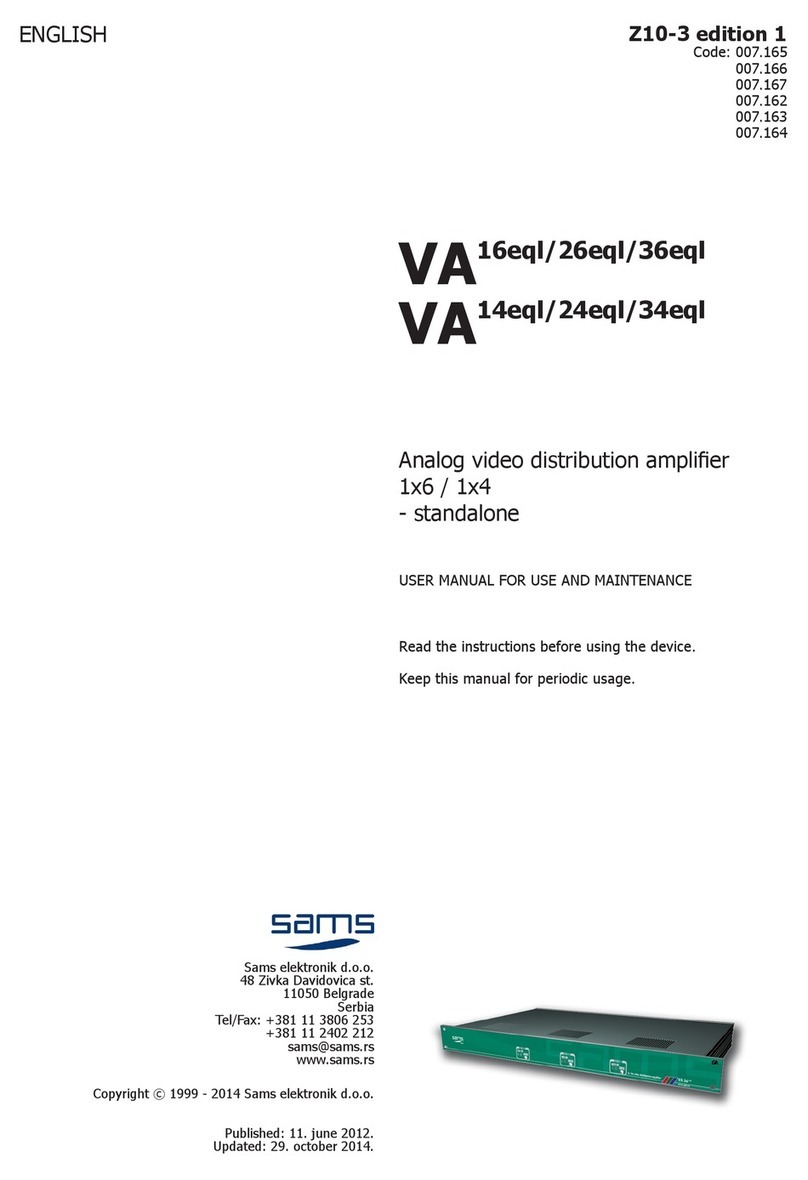
Sams
Sams VA-16eql User manual for use and maintenance
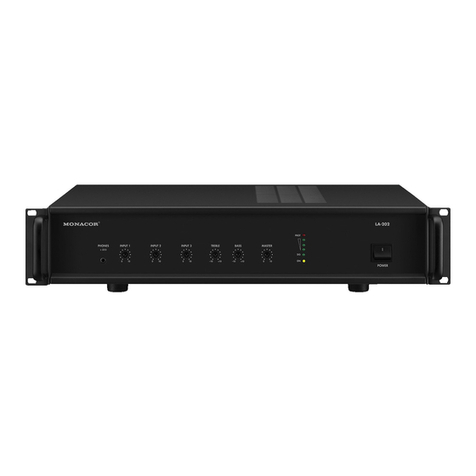
Monacor
Monacor LA-402 instruction manual

